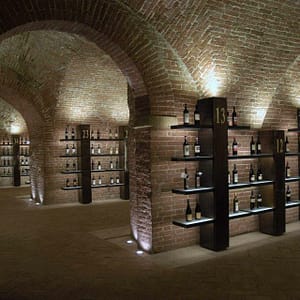OUR HISTORY
Italy has always been a favorable environment for the cultivation of vines, thanks to its particular geographical configuration and its exceptional microclimate. Over time, the number of native vines in the country has resulted in a great variety of wines produced in each region. However, until 1930, wine production in Italy was not subject to any legislation that would protect and enhance its production. The first law on typical Italian wines was passed by Parliament in this year. From that moment on, the history of modern Italian viticulture began, and Siena immediately seized this opportunity deciding to give life in the following years to a structure that would promote the wine trade and its growth in terms of quality and productivity.
INAUGURATION OF THE FIRST EXHIBITION OF TYPICAL ITALIAN WINES
1933


It was in 1933, more precisely on August the 3 rd, , when the First Exhibition of Typical Italian Wines was inaugurated in Siena, housed in the Fortezza Medicea and organized by the Sienese institutions under the patronage of the Ministry of Agriculture.

It was about a biennial review of Italian wine excellences (the denominations of controlled origin would arrive exactly 30 years later), crafts and manufacturing related to the cultivation of vines and the production of wine.
Since the first edition, the regional stands welcomed over one hundred thousand visitors, making Siena the national capital of wine. The exhibition was an event aimed to spread the knowledge of the finest wines, to create and intensify relations between producers and consumers and, in line with the autarchic spirit of the time, to support a national production threatened by other foreign beverages.

1935

The success of the first edition was repeated two years later. The second Exhibition-Market of Typical Italian wines, held in the Fortezza Medicea in Siena from 3rd to 18th August 1935, saw the program of activities also enriched by the Siena Prize. This competition of “Bacchic poetry, love and warrior”, had a jury chaired by the father of Futurism Filippo Tommaso Marinetti. The competition was won by the Tuscan artist Lorenzo Viani with “Sarabanda del vino” and by the futurist Farfa with the poem “Veni, Vidi, Viti”
It was on the occasion of the award dinner that Marinetti, in perfect Futurist style, climbed the table, lifted the glass and said: “Brunello is gasoline!”

1937

The union between poetry and wine continued also on the occasion of the exhibition held in 1937 .The competition was won by the Sienese Dina Cucini, with the poem “Wine”. The third edition of the exhibition opened once again “to all categories of agricultural work and the wine industry”, as stated in the short report of the newsreel Luce dedicated to the inauguration. The fourth edition, held in 1939, was the last before the suspension decided the following year due to the outbreak of World War II.

THE EXHIBITION BECOMES A RECOGNISED PUBLIC INSTITUTION
1950

The year after the very young Italian Republic formally recognized the value of the Exhibition-Market. On 14th March 1949, the National Exhibition of Fine and Typical Wines, was founded. It was established on the initiative of the Municipality of Siena, the Provincial Administration of Siena and the Chamber of Commerce of Siena, to which were then added other important local associations. Little more than a year after the formal recognition took place. It was on 6th August 1950 when a decree of the President of the Republic Luigi Einaudi, granted legal personality to the “Ente Mostra Mercato dei Vini Tipici e Pregiati”, specifying its seat: Siena
The acknowledgment was granted on “documented request submitted by the commissioner of the Provincial Administration of Siena, the mayor of the city of Siena and the president of the Chamber of Commerce, Industry and Agriculture of Siena”
The aims were well summarized in Article 1 of the Statute: the “Ente Mostra Mercato dei Vini Tipici e Pregiati” develops and continues the Exhibition of Typical and Valuable Italian Wines, created on the initiative of Sienese Institutions. Since 1933, it has ensured the implementation in Siena of a periodic exhibition of wines, machines, tools and accessories, industry and trade of wines and products derived from the wine industry. The Ente Mostra Mercato will be able to study, promote and implement, also in union with other organizations, all those initiatives that it will consider advantageous for the affirmation and valorization of the typical and valuable national wines, both in Italy and abroad”.

ENOTECA ITALICA PERMANENTE OPENS ITS DOORS
1960

The Exhibition of Typical and Fine Wines continues with the editions of 1951, 1953 and 1955. In 1960, the experience of the biennial fair is abandoned to replace it with a permanent structure, an exhibition-market open 365 days a year. This is how the Enoteca Italica Permanente was born.

THE WEEK OF TYPICAL WINES
1966

Since then and for about half a century, the Fortezza Medicea and what for simplicity has become “Enoteca” (the transition from “Italica” to “Italian” dates back to 1990) have been a landmark for everything concerning wine making and national wine production. This is thanks to the exhibition of thousands of wines (up to 1600 simultaneously) selected by a commission of experts, and to international thematic conferences hosted with the cooperation of important international organizations and, since 1966, the “Week of Typical Wines”, heir to the Exhibition Market.
Since 1986 Enoteca Italiana has extended its role abroad with the participation in the main exhibitions in Europe, Canada, China and Japan. The production of numerous publications in various languages also contributed significantly to increasing the knowledge of Denominations of Origin wines abroad.

THE 2000s

With the beginning of the new millennium, the promotional activity in Italy and abroad continued unceasingly. Unfortunately, over the years, a large part of the economic contribution that had supported the activity of the institution will be missing, leading to the closure of the headquarters of the Enoteca Italiana and the dissolution of the historical Ente Mostra Mercato dei Vini Tipici e Pregiati.

